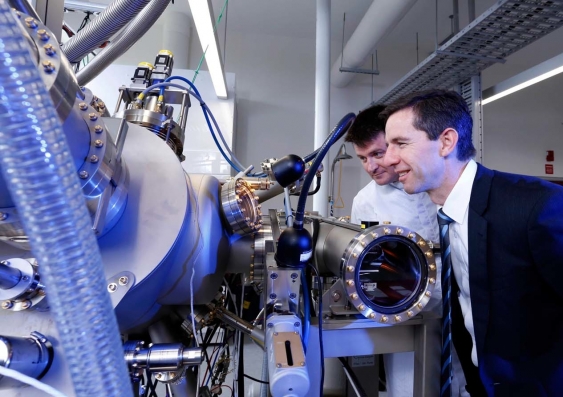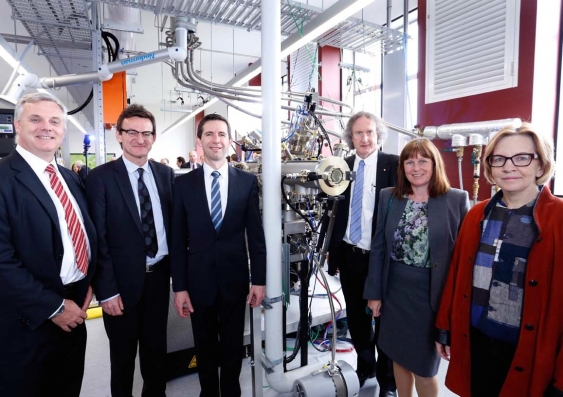Education Minister opens industry-focused laboratory for advanced materials at UNSW
The federal Minister for Education and Training, Senator Simon Birmingham, has opened a new $3.3 million laboratory at UNSW for the creation of advanced materials.
The federal Minister for Education and Training, Senator Simon Birmingham, has opened a new $3.3 million laboratory at UNSW for the creation of advanced materials.

The federal Minister for Education and Training, Senator Simon Birmingham, has opened a new $3.3 million laboratory at UNSW for the creation of advanced materials.
“The UNSW Epitaxial Growth Laboratory provides researchers and industry with a one-of-a-kind capability in advanced materials fabrication for devices that have the potential to revolutionise sectors such as telecommunications, health, and energy,” Senator Birmingham said.
“Innovation will drive future competitiveness, and by investing in infrastructure like this state-of-the-art laboratory, we are investing in Australia’s future.”
The Epitaxial Growth Laboratory is the latest of eight specialist Australian National Fabrication Facility (ANFF) research nodes funded by the Australian Government through the National Collaborative Research Infrastructure Strategy (NCRIS).

In the new laboratory....(L-R) Dean of UNSW Engineering Professor Mark Hoffman, UNSW Scientia Professor Andrew Dzurak, Education Minister Simon Birmingham, UNSW Deputy Vice-Chancellor (Research) Professor Les Field, CEO of ANFF Ltd Rosie Hicks, and NSW Chief Scientist and Engineer Professor Mary O’Kane. Photo: Grant Turner/Mediakoo
“The ANFF brings together around 20 Australian universities and the CSIRO to support high quality research that has the potential to deliver economic growth and innovation,” Senator Birmingham said.
A number of Australia’s leading research scientists and representatives from industry were on hand to help launch the new laboratory, including the NSW Chief Scientist and Engineer, Professor Mary O’Kane, and the CEO of ANFF Ltd, Rosie Hicks.
The Australian National Fabrication Facility (ANFF) at UNSW is a major complex of advanced “clean-room” laboratories valued in excess of $30 million.
“Innovation will drive future competitiveness, and by investing in infrastructure like this state-of-the-art laboratory, we are investing in Australia’s future.”
It provides researchers with access to state-of-the-art micro- and nano-fabrication facilities, with a strong focus on supporting Australian industry.
“This new laboratory will allow researchers to custom design completely new materials, with properties that cannot be found in nature,” said Scientia Professor Andrew Dzurak, who is the ANFF director at UNSW.
The new laboratory houses three tools that use an advanced crystal growth technique known as molecular beam epitaxy (MBE) which allows for the fabrication of materials one atomic layer at a time. MBE techniques enable new technologies by allowing researchers to enhance the performance of existing materials, and to create new materials not possible by any other method.
“The new epitaxial growth facilities, combined with our existing ANFF laboratories, will enable Australia’s researchers to address key national and global challenges, for the well-being of everyone on our planet,” Professor Dzurak said.
“The research to be supported includes new solar energy technologies, advanced quantum devices, and new sensors for medicine and the environment.”
Australia is already providing significant leadership in a number of these fields with internationally renowned researchers in quantum computing and solar cell technologies having strong linkages to the laboratory.
Earlier this month Professor Dzurak announced that his group had performed the first ever calculations between quantum bits in silicon, using devices fabricated using the ANFF facilities at UNSW.
The new epitaxy tools were funded under the Australian Research Council’s (ARC) Linkage Infrastructure, Equipment and Facilities (LIEF) program. This support includes provision of highly skilled technical personnel to operate the complex machinery and provide expertise in materials development to researchers and industry.
While at UNSW, Minister Birmingham also visited the Australian Research Council’s Centre for Sustainable Materials Research & Technology (SMaRT@UNSW) and lab facilities. The Centre, led by UNSW Scientia Professor Veena Sahajwalla, is a world leading research and development unit specialising in both the science and the real world application of waste transformation.
SMaRT@UNSW has gained recognition for developing world-first Australian innovations that are now being commercialised around the world. “Plastics, rubber tyres and electronic waste are consequences of industrialisation and lead to pollution in developing countries. It is imperative to employ sustainable recycling techniques to meet the challenge,” Professor Sahajwalla says.
In 2015 the SMaRT Centre was awarded funding for a prestigious Australian Research Council Industrial Transformation Research Hub, the first of its kind in Australia.